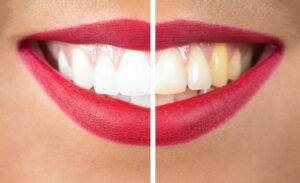Do you have discoloration on your teeth that disrupts your beautiful smile? Many people aspire to keep their teeth pearly white in color. But you can develop stains that interrupt the smile of your dreams in many ways.
In fact, there are several types of dental discoloration that can affect your smile. Your dentist can evaluate aesthetic concerns in your teeth and find an individualized treatment plan to make your smile brighter through cosmetic dentistry.
Schedule a dental consultation today to get started on whitening your unique smile. And learn more about the differences between stains that can form on your smile along with the treatments your dentist can recommend to address them when you read on.

Extrinsic Dental Stains
Extrinsic dental stains, also known as surface stains, refer to dental discoloration that develops just below the enamel. While close to the surface, these stains are just far enough that a toothbrush cannot reach them to wash them away. They often appear as dark spots on your teeth.
Extrinsic stains usually form due to the consumption of substances that contain staining agents. For instance, dark-colored foods and drinks often get their color from naturally occurring substances called tannins. These tannins transfer to your teeth while eating and drinking and then absorb into the enamel to create stains.
In many cases of extrinsic stains, a dentist will recommend professional teeth whitening treatment to remove the discoloration. The process involves a dentist applying bleaching varnish to the teeth which will lift stubborn stains to the surface. Then the dentist can easily scrub away the dental discoloration, leaving your smile several shades brighter.
The dentist can also recommend a take-home option that will whiten your teeth. They will build custom-made trays based on impressions of your unique smile. Then you put bleaching gel into the trays and wear them as directed to gradually lighten your tooth color. Follow your dentist’s aftercare instructions to ensure you keep your teeth bright after this whitening treatment.
Intrinsic Dental Stains
Not all types of dental discoloration will respond to this whitening treatment. You might develop intrinsic dental stains, which occur even deeper in the enamel where bleaching ingredients cannot reach. Your dentist can still help you achieve a brighter smile though.
Intrinsic dental discoloration might develop due to multiple factors, including those outside of your control like aging or medication side effects. You can discuss ways to preserve your tooth color with your dentist.
Your dentist can brighten your smile if you have intrinsic tooth stains with treatments like porcelain veneers. These custom-made shells will cover dental discoloration and make your smile brighter without appearing unnatural. They mimic the sheen and color of your natural teeth, and the fixtures seal into place using bonding.
The veneers resist further staining so that you can look forward to long-lasting smile enhancement. Durable veneers can withstand everyday wear and tear and remain on your smile for fifteen years. Discover maintenance tips by contacting your dentist about porcelain veneer treatment today.
